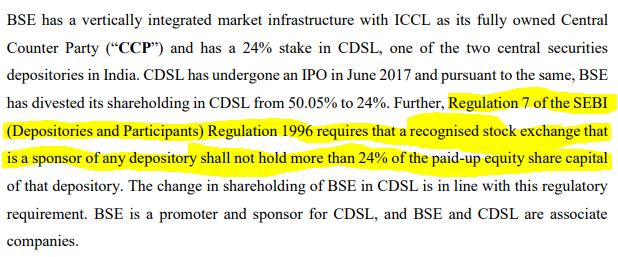I saw this post on Twitter a few months back. I replied there too. I’m sorry to be the Devil’s Advocate here, but there is a very central problem that this post ignores completely.
I completely agree with the fact that CDSL (Or any exchange for that reason) has the capability of producing a gush of FCF and a float to boot. But it begs the question of what they are doing with all this money.
A firm can do 4 different things with the money on its books:
- Pay Dividends: CDSL is already doing this to some extent. But among all the methods, this is the least preferred, for taxation reasons.
- Do Acquisitions (Inorganic Growth): Another fine use of Cash is to pay for Growth. However, CDSL cannot do this at all.
SECURITIES AND EXCHANGE BOARD OF INDIA (DEPOSITORIES AND**
**PARTICIPANTS) REGULATIONS, 2018:
“…the depository shall not carry on any activity whether involving deployment of funds or otherwise without prior approval of the Board: Provided that prior approval of the Board shall not be required in case of treasury investments if such investments are as per the investment policy approved by the governing board of depository.”
-
Invest Efficiently: In many ways, the most logical method of all. However, CDSL really does not have any need for reinvestment (That is, investments in the core business). Don’t trust me? CDSL’s IPO was worth roughly Rs. 523.99 Crores. Two years in, the firm’s Cash and Cash Equivalents (Investments) stands at Rs. 650 Crores. So, not only did CDSL get any chance to reinvest the IPO proceeds, but that money is largely sitting in bonds and Mutual Funds. If the major aim of collecting so much cash on the Balance Sheet was only to invest in securities, then it’s better to let the shareholders decide what securities they would like to invest in i.e. Pay dividends, regardless of it being the poorest method of utilizing cash. In fact, I would go so far to say that CDSL did not need the IPO at all. It is likely the early investors and/or promoters wanted to exit the stock, so the retail investors were given the privilege of holding bonds and Mutual Funds at a steep cost.
-
Do Buybacks: When I wrote my blog post, I had mentioned that this was the most efficient method to utilize cash for CDSL (Again, going with my statement that CDSL did not need the IPO - so, a buybacks are essentially like correcting the mistake of the IPO, one piece at a time). But again, this is not possible for CDSL beyond a point. In a letter written by BSE to SEC, we see the following:

If CDSL buys back its own stock and writes it off, BSE’s holding in CDSL will increase, and it cannot go beyond 24%. It is true that BSE itself can tender shares for the buyback, but the risk of making sure that the holding does not go beyond 24% accidentally is high. Imagine if BSE’s tendered shares don’t get accepted - it means that someone else’s shares were, which will further increase BSE’s stake. BSE cannot get a preferential treatment too, since everyone is the same in the eyes of SEBI during a buyback. What a bummer!
Now, after the announcement of Buyback Tax, that’s another red mark on Buybacks.
So in conclusion, CDSL is a duopoly business with both an upside cap and downside protection on Margins (Read my blog post to know more). But due to the organic nature of demand and the decreased need for Capex, it is able to produce a flush of FCF and by virtue of their business model, some float also to boot. But the exchange, due to several regulations and restrictions, is unable to utilize the cash efficiently to deliver shareholder value. As discussed above, the best way to utilize the cash seems to be Dividends, although ironically Dividends are the least efficient way to utilize cash for many companies.
In my eyes at least, CDSL should become a massive dividend payer (Even ~90% Dividend Payout would be completely justified), which is the best way in which they can create shareholder value. If your expectation from CDSL is anything else other than a slow, consistent grower with a butt-load of Dividends, then you should probably revisit your investment thesis.

